Buffalo MiniStation Thunderbolt Review - An External with USB 3.0 and Thunderbolt
by Brian Klug on August 1, 2012 4:04 PM EST- Posted in
- Storage
- SSDs
- USB 3.0
- Thunderbolt
- Buffalo
To test the MiniStation Thunderbolt I turned to a combination of Intech’s QuickBench and the BlackMagic Disk Speed Test application from the Mac App store. I tested on my 2011 MacBook Pro, which has a first generation Light Ridge Thunderbolt controller inside. For testing on OS X, I used native HFS+ formatting for the MiniStation.
| BlackMagic Disk Speed Test - 2011 MBP | |||||||
| 500 GB HDD | 240 GB OCZ Vertex 3 | ||||||
| Read (MB/s) | Write (MB/s) | Read (MB/s) | Write (MB/s) | ||||
| USB 2.0 | - | - | 28.4 | 34.7 | |||
| Thunderbolt | 112.5 | 110.9 | 269.8 | 370.5 | |||
There’s no USB 3.0 on my 2011 MacBook Pro, so for USB 3.0 I turned to my desktop which has a Renesas based USB 3.0 controller, and reformatted the drive to NTFS. I used CrystalDisk Mark to test.
With the HDD inside, you basically get the kind of speeds you’d expect were the drive connected natively over SATA. Keep in mind, with the 1 TB HDD, speeds will actually be slightly higher thanks to the higher storage density.
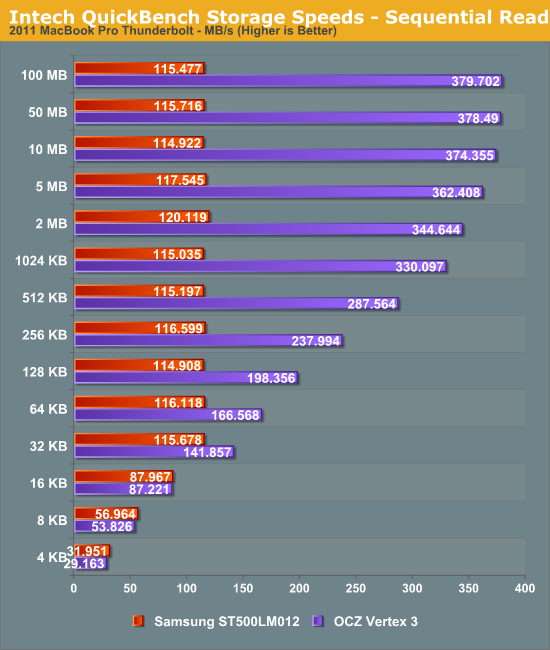
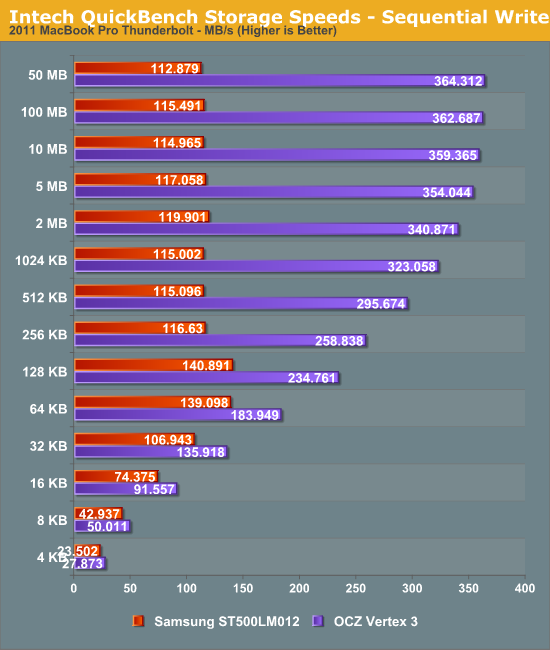
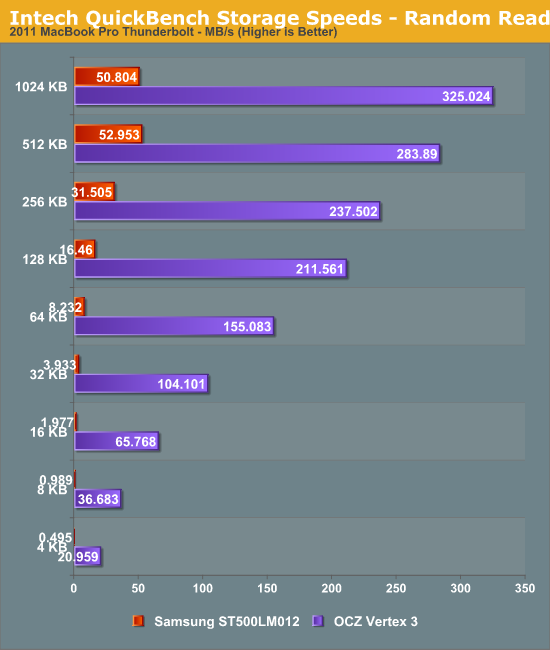
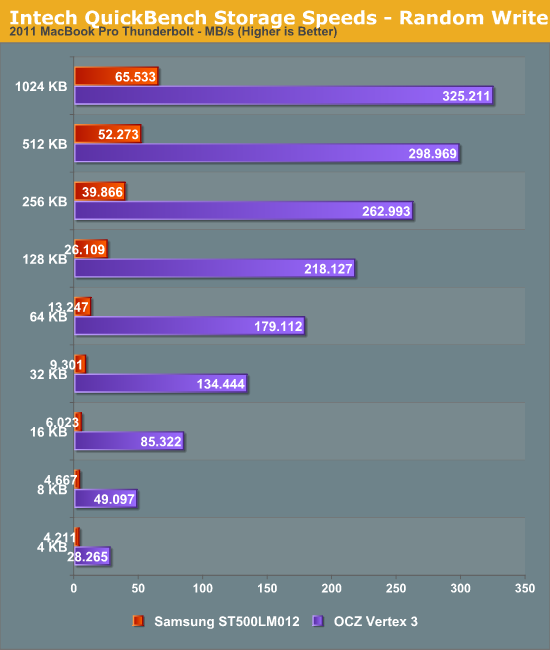

Looking at the QuickBench scores, the Vertex 3 performs just as well inside the MiniStation as it does connected to a 6Gbps SATA controller in our Bench test bed.
When connected over Thunderbolt on OS X, in System Profiler you can see the drive attached over an AHCI controller just like any internal drive, and with TRIM enabler patched kexts on OSX you can even TRIM the SSD. Buffalo has no plans to sell a bare external enclosure for people to stick their own SSD in, but at the current price point upgrading it yourself is a pretty viable option.
In addition to stressing the drive with the BlackMagic Disk Speed Test app set to 50 GB, I filled the stock HDD with random data by running good ol’ dd with data from /dev/urandom, a favorite test of mine for all storage that comes my way. Just run “dd if=/dev/urandom of=test.bin” in the root of the drive, and let it fill up. The drive’s aluminum underside does a great job conducting heat away, and gets somewhat warm (after all, it is doubling as a heatsink, and aluminum has great thermal conductivity) during use. Even with hours of constant Thunderbolt and HDD access, the drive didn’t overheat or disconnect at all with the HDD inside. I’ve also stressed the drive with the SSD inside (an unsupported configuration) and didn’t encounter any issues.
Anand noted in his original Thunderbolt piece that the cable connectors at the endpoints get warm, and measured 27.6C at the end of a cable. I ended up measuring a notably warmer temperature of over 35C during my stress testing of the drive, but my ambient temperature in AZ is also hotter than Anand’s in NC. When you consider that there’s an active component at the end of both sides of the cable (a Gennum GN2033), this isn’t altogether surprising, but it is disconcerting to feel the cables get noticeably warm during use.


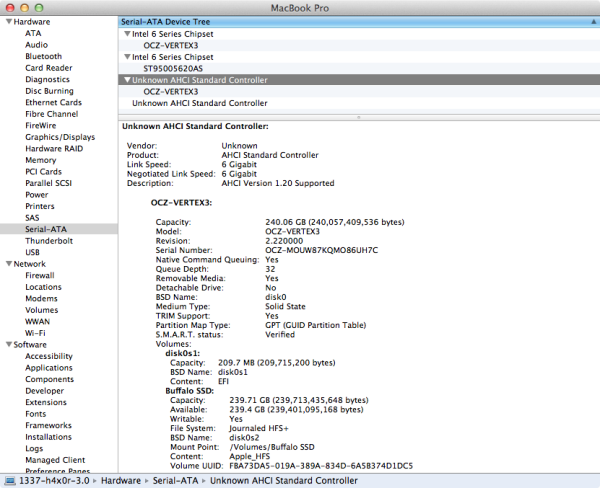









61 Comments
View All Comments
lin2log - Thursday, August 2, 2012 - link
Which part of: "Don't get it? Don't need it? Then don't BUY it." is confusing you exactly?AnnonymousCoward - Thursday, August 2, 2012 - link
lin2log, you're nothing but nonsense.500GB USB3 external drives are $70. Yet somehow, $200 is an affordable price point. What a joke.
Dman23 - Wednesday, August 1, 2012 - link
I've been waiting for an affordable external SSD from Buffalo. This is great!! Faster thunderbolt speed, with the option to go USB 3, at an affordable price. Excellent!!!Sm0kes - Thursday, August 2, 2012 - link
Ummm.... this doesn't offer an SSD as an option.philipma1957 - Wednesday, August 1, 2012 - link
Lets see t-bolt can do about 800 mbs read write. so you put in a hdd that does about 100 mbs read write why? last month crucial was selling 512gb ssds for under 375. Why not drop a big ssd in this .Then sell it for 550- 600 and call it a day?
Jaybus - Thursday, August 2, 2012 - link
Because the previous gen MB Pros do not have a USB 3.0 port. TB is overkill for a hard drive, but the only other option for last gen MB Pro owners is USB 2.0 which drastically slows down even the hard drive.sicofante - Thursday, August 2, 2012 - link
So let's make this clear once and for all:If you buy one of those Apple computers that refrain from using the standard USB 3.0 ports, you are forced into a very expensive standard that won't give you anything extra except when:
a) The peripheral is capable of extremely high speed transfer rates (>5 Gbps that is offered by USB 3.0)
b) The peripheral can be hooked to a chain of TB devices (i.e. has TB passthrough).
Buffalo fails to make it in both cases.
You buy expensive Apple hardware? You've been properly punished by not being allowed to use USB 3.0 peripherals and forced to use an overkill (for the purpose) ultra-expensive technology instead.
You didn't fall into Apple's trap? Nothing to see here. Move on.
KitsuneKnight - Thursday, August 2, 2012 - link
All Thunderbolt devices can be hooked to a chain. Some can be in the middle (ones with passthrough) and others have to be at the end (like this one).Your post comes off as incredibly angry and bitter... why? "properly punished"?
Impulses - Wednesday, August 1, 2012 - link
Yeah, the only way this product makes any sense is if they sell it with an SSD to begin with... There's no tangible benefit to the huge TB price premium compared to cheap USB 3.0 HDD.philipma1957 - Wednesday, August 1, 2012 - link
I use a lacie little big disk with 2 ssds in it. an easy mod. I put in 2x 256gb samsung ssds. I use it as an external boot drive for a mac mini and the internal slow 500gb oem is my backup easy peasy. 4 screws and the case is open.I don't understand the use of a slow drive like the one in this case.